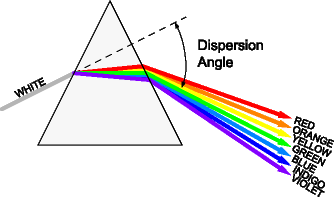The color sensitive cone cells of the human eye are of three types, S-cones, sensitive mainly to blue, M-cones, sensitive mainly to green, and L-cones, which are actually most sensitive to a sort of orangey-yellow, but are often described as red-sensitive (see diagram). Anyway, nearly all the M and L cones are clustered tightly together in the fovea, the relatively small region at the center of the retina of the human eye, which has by far the greatest acuity of any part of the retina. Nearly all of our normal visual experience (except in very low light, when we use the non-color-sensitive rod cells of the more peripheral parts of the retina), and effectively all of our experience of color is mediated via the fovea, rather than the rest of the retina, but the fovea, in fact, only encompasses about 2º of visual solid angle at the center of the visual field, about the size that your thumbnail appears when held at arm’s length. Most of the brain’s visual cortex is dedicated to processing information coming in from the fovea, and only a small proportion to the information arriving from the remaining parts of the retina (which are much larger in area, but have fewer light sensitive cells, most of which are color-insensitive rods, anyway).
Things look distinctly colored and sharply detailed to us only inasmuch as they are focused on the fovea, and the visual world as a whole seems distinctly colored and detailed only because whenever we want to check whether some portion does appear colored and sharply detailed, we (mostly unconsciously) move our eyes to look directly at it, and focus it on the fovea. Color discrimination (and acuity) in the rest of the visual field is poor (in regions relatively close to the fovea) to non-existent in the periphery (the “corners” of your eye).
However, unlike the M and L cones, that are tightly packed together in the fovea. The blue sensitive S-cones are distributed much more evenly, but relatively sparsely, across the whole retina. This means that even in the fovea, the S-cones are fairly far apart from one another, as compared to the densely packed M and L cones there, and in the very center of the fovea, the foveola, where the M and L cones are packed most tightly of all (to give the highest possible acuity, the highest possible ability to resolve fine detail) there are no S-cones at all. This means that we simply cannot see blues at all with our eyes’ highest level of resolving power, which only works for the longer wavelengths in the green, yellow, and red parts of the spectrum, where the M and L cones operate. Even in the rest of the fovea, around the foveola, the red and green resolving power is considerably greater than that for blue. Thus, as you have observed, when you look at something of a pure blue color it will look fuzzy as compared to how an otherwise similar thing of another color will look. This is going to be particularly noticeable with things like LEDs, whose colors, in spectral terms, are a lot purer than those of most other types of colored objects.
